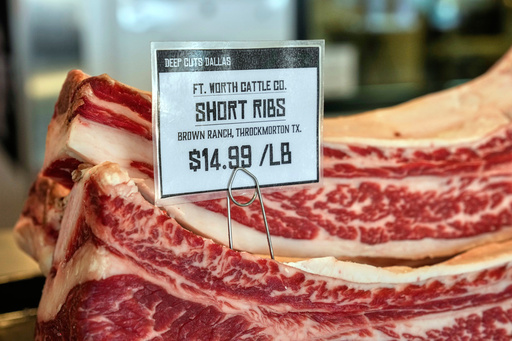In an era of unprecedented retail beef prices, South Dakota rancher Calli Williams wishes to benefit from the trend, but her aspirations face significant hurdles.
Calli and her husband, Tate, manage approximately 70 cow-calf pairs on their farm near Letcher in southeastern South Dakota, about 18 miles north of Mitchell. With ownership of about 80 acres and additional rented pasture, they are struggling to upscale given the circumstances.
Despite the opportunity presented by high beef prices, challenges such as recovering from drought impacts, limited grass for feed, and rising land costs, make expansion difficult. “Expanding is our goal,” Williams noted, “but achieving it might take over a decade.”
Biological constraints significantly impede ramping up cattle production. Farmers nationwide face similar hurdles, as meeting beef demand is not quick due to the extensive time required for breeding and raising cattle. Michael Swanson, chief economist at Wells Fargo Agri-Food Institute, emphasized that “it takes three years to increase cattle numbers, considering the breeding and maturation timeline.”
Although recent rainfall has eased drought conditions in the Williamses’ county, the repercussions linger. The previous lack of feed due to drought forced them to sell young females that could have bolstered their herd. This current “abnormally dry” classification in the U.S. Drought Monitor signals recovery, yet the ranchers remain cautious.
Weather unpredictability, a characteristic of the natural conditions from Canadian prairies to Texas, poses an ongoing challenge. Colin Woodall of the National Cattlemen’s Beef Association acknowledges, “Ranching is cyclical, with inevitable highs and lows following the industry downturn during the pandemic in 2019-2021.”
Fears of impending drought curb investments in rebuilding herds. Woodall’s members are wary, contemplating whether favorable weather will persist, as rebuilding a herd only to potentially liquidate it quickly could be financially disastrous.
While singular weather events like droughts are hard to attribute directly to climate change, scientists indicate that rising temperatures likely exacerbate these occurrences. This exacerbates financial pressures on farmers operating within tight margins.
The economic scenario reveals steep retail beef prices, with no immediate relief expected for consumers. In June, ground beef surged nearly 12% compared to last year, reaching an average of $6.12 per pound, while steak prices climbed to $11.49 per pound.
Yet, the U.S. cattle herd continues to shrink. As per USDA data, herd numbers have reached a historic low since the mid-1980s. Notably, U.S. cattle and calves numbered 94.2 million as of July 1, decreasing from the midyear peak in 2019 of nearly 103 million. Despite little indication of herd rebuilding, consumer demand remains robust.
Glynn Tonsor of Kansas State University points out that taste preferences significantly influence protein purchases. Beef leads despite the costs, with consumers ready to pay more for quality. June figures show shoppers were willing to spend significantly more on beef cuts compared to pork or chicken.
Woodall attributes this trend to an emphasis on superior taste in beef production. Modern efforts ensure that premium-quality beef, once exclusive to dining establishments, now graces grocery store shelves.
For those deterred by beef prices, abundant pork and poultry provide cheaper alternatives, explained livestock marketing expert Derrell Peel.
The Williams family, in their mid-30s, emerged as ranchers through diligent efforts, commencing their TW Angus enterprise from zero. Tate Williams initiated cattle purchases during high school and secured land in 2015. Their operations include selling bulls, raising heifers, and direct marketing beef consumers.
“We aim to grow our business and pass it to future generations,” Calli Williams expressed, thinking of sons Jack and Tommy. Despite setbacks, ranchers remain resilient. “We trust Mother Nature might offer us a reprieve next season, or favorable markets will eventually return,” added Calli, reflecting their optimism despite adversities encountered.


